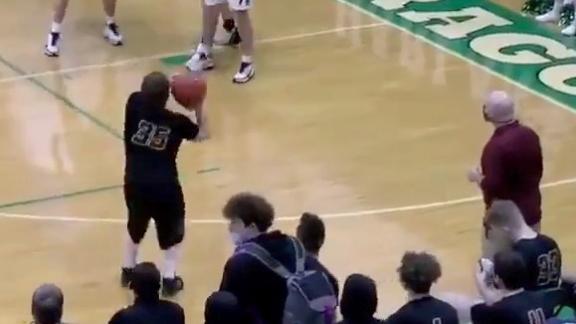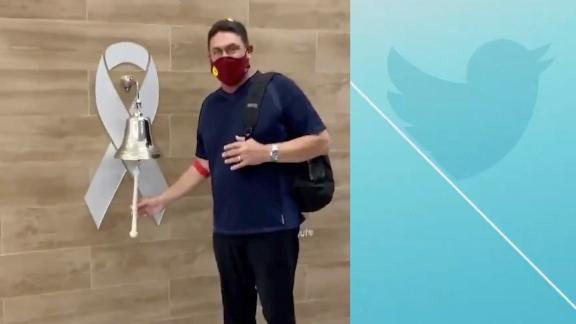In 1984, pro vert rider Mike Dominguez attempted a flyout that astonished fellow pros and early BMX fans. In mid-air, Dominguez kicked the bike out under his feet, attempting to whip the bike around underneath him. Today, it's better known as a tailwhip, but in the mid '80s, it was a BMX impossibility discussed in passing by the pros of the time.
Four years later, a pro from Massachusetts by the name of Joe Johnson changed all that. Johnson had come up through the local vert ranks in the New England area, got picked up by Haro and quickly made a name for himself by blasting huge airs and stretching variations in a Hoffman-like fashion. Johnson was also not afraid to innovate.
By 1988, Johnson had left Haro and was riding the contest season as an independent alongside Dennis McCoy, but his thoughts were on the tailwhip. "Everyone at the time was talking about it, whether it could be done. It wasn't my idea. I mean, I thought of it on my own, but everyone else thought of it on their own too. It seemed like an obvious progression at the time." says Johnson. "I just fooled around with it in early '88. Dennis McCoy and I were doing demos in Europe, and somehow, we got stuck in this warehouse with a quarterpipe. It was a down day and we had the place to ourselves. It was a ten-foot tall ramp with a 12-foot transition, and really wide. All day, I fooled around with getting the bike around, under coping. I played with it that day, and it seemed like I was close enough that it could be done. I worked on it some more when I got home and kinda gave up on it," he adds.
Johnson returned to the U.S. and went back to trying the tailwhip in the summer of 1988, ultimately landing the trick just before round five of the AFA Masters in Wayne, N.J. "It took forever to finally land it, and it was under coping, with one foot on the frame and one foot on the pedal. But I was pretty fired up when I landed it," he says.
The tailwhip technique was an issue Johnson constantly dealt with. Whipping the bike around was not a problem for him, but landing presented two options that Johnson battled. "Landing with one foot on the frame and one foot on the pedal is definitely not the right way to do them. But that's how I always did it. Pedal to pedal, I could never land smooth. I wish I worked on it more, cause you can go way higher, land front wheel first and get a pump for the next wall," he says.
Johnson planned on debuting the tailwhip at the N.J. AFA contest. "I tried to keep it under wraps, but I told a few people the night before at the hotel. They didn't believe me, but I told them to check it out the next day," he says, adding that he wasn't pulling tailwhips consistently just yet. "I only landed it a few times before that. I tried it a couple of times in practice, and I don't even think I landed it in practice. I remember getting the bike around, and landing one foot on the ramp and one foot on the frame. I landed it in my run though."
The crowd didn't quite know what to think of Johnson's tailwhip. Because Johnson aired to the right, and the crowd at the Wayne Masters was seated on the left, they could only see the back of Johnson tailwhipping to the right. Johnson placed second in pro vert, behind former Haro teammate Ron Wilkerson. And the tailwhip did not seem to have as big an impact as Johnson envisioned. "The crowd didn't know what it was," he says.
That changed when issue 44 of Freestylin' Magazine hit the newsstands. The tailwhip was now a reality, and Joe Johnson was the owner. One year later, tailwhips were now a possibility, but Joe Johnson wasn't done with the progression of the trick. He went on to learn double tailwhip airs, and was now doing the trick at height on vert ramps. Johnson also went on to attempt a triple tailwhip air at a Woodward 2-Hip contest in the summer of 1989. He did not land the trick, and only attempted it once, but the crowd was in shock. "I crashed, and never really expected to land it," says Johnson. He took first in pro vert.
Things were different after that. Other riders learned the once-impossible air, including a a rookie pro named Mat Hoffman. The trick transcended vert and was attempted on dirt and launch ramps, mimicking the technique Dominguez had used some years before. Tailwhips became ubiquitous throughout BMX.
Johnson would go on to leave GT and return to school full-time in 1991, studying mechanical engineering and fading from the BMX scene, but his mark never left. And to this day, BMX owes a huge debt of gratitude to Joe Johnson. "It's pretty amazing how much weight landing the first tailwhip seems to carry. I just look at it as another trick," says Johnson. "I knew it was bigger than other tricks, but I think it's cool to have my name attached to that," he humbly adds.
Today, Johnson lives in Massachusetts and works as a mechanical engineer. He still works part-time on Dew Tour events alongside Dennis McCoy, and rides from time to time. Last year, Johnson showed up for the Old School Reunion at Woodward West and proceeded to blast the indoor quarterpipe with trademark Johnson style. But his legendary mark on BMX has recently escaped him. "I had tailwhips pretty dialed for a long time. And that's a trick I thought I'd never lose, but I can't do it anymore," says Johnson.
Even though Joe Johnson is no longer doing tailwhips, hundreds are done every day of the year, and that's all due to Joe Johnson's quest in 1988.




